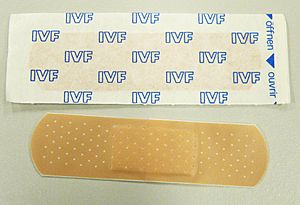Adhesive bandage facts for kids
An adhesive bandage is a small medical patch. It's used for minor injuries like small cuts and scrapes. This handy patch helps protect the wound. It keeps out germs, dirt, and stops more damage. An adhesive bandage also helps your body heal itself. Some types even have special medicine to fight germs. They can also hold the edges of a cut together. This helps the skin close up and heal faster. However, some people might be allergic to the materials in the bandage.
Contents
What Are Adhesive Bandages?
Adhesive bandages are also known as sticking plasters or Band-Aids. They are a common item in first-aid kits. These simple patches are designed to cover small wounds. They are not for serious injuries that need a doctor. Their main job is to keep the wound clean. This prevents infections from bacteria and dirt.
How Do They Work?
An adhesive bandage has a few main parts. It has a soft, absorbent pad in the middle. This pad goes over the wound. It soaks up any blood or fluid. Around the pad is a sticky area. This part helps the bandage stay on your skin. A protective backing covers the sticky part before you use it. You peel this backing off to apply the bandage.
The bandage works by creating a barrier. This barrier stops germs from getting into the wound. It also protects the wound from rubbing against clothes or other things. By keeping the wound clean and protected, the bandage helps your body's natural healing process. It gives the wound a safe environment to recover.
Different Types of Bandages
There are many kinds of adhesive bandages. Some are made for specific body parts, like knuckles or fingertips. Others are designed for different types of wounds.
- Standard Bandages: These are the most common type. They come in various sizes and shapes.
- Waterproof Bandages: These have a special film that keeps water out. They are great for showering or swimming.
- Blister Bandages: These often contain a gel-like material. They help cushion blisters and promote healing.
- Butterfly Closures: These are narrow strips. They are used to hold the edges of a small cut together. They act like stitches for very minor wounds.
- Antiseptic Bandages: Some bandages have a special chemical on the pad. This chemical helps kill germs and prevent infection.
When to Use a Bandage
You should use an adhesive bandage for:
- Small cuts
- Minor scrapes
- Blisters
- Tiny punctures
Always clean the wound gently with soap and water before putting on a bandage. Make sure your hands are clean too. Change the bandage regularly, especially if it gets wet or dirty.
When Not to Use a Bandage
Do not use an adhesive bandage for:
- Deep cuts that won't stop bleeding
- Wounds with jagged edges
- Wounds that show bone or muscle
- Animal bites
- Burns that are large or blistering
For these types of injuries, you should always get help from an adult or a doctor.
History of Adhesive Bandages
The idea of an adhesive bandage came about in the early 20th century. A man named Earle Dickson invented the Band-Aid in 1920. He worked for Johnson & Johnson. His wife, Josephine, often cut herself while cooking. Earle wanted an easy way for her to bandage her own small wounds. Before this, people had to cut strips of adhesive tape and gauze separately.
Dickson put a piece of gauze in the middle of a strip of adhesive tape. Then he covered it with a protective crinoline fabric. This made it easy to unroll and use. His boss liked the idea, and Johnson & Johnson started making them. At first, they were made by hand and not very popular. But by 1924, machines started making them. They became a huge success, helping millions of people with their minor injuries.
Images for kids
-
A hydrogel dressing. An entirely transparent adhesive bandage, with a transparent hydrogel pad and adhesive waterproof plastic film (removable backing is blue and white).
See also
 In Spanish: Tira adhesiva sanitaria para niños
In Spanish: Tira adhesiva sanitaria para niños





